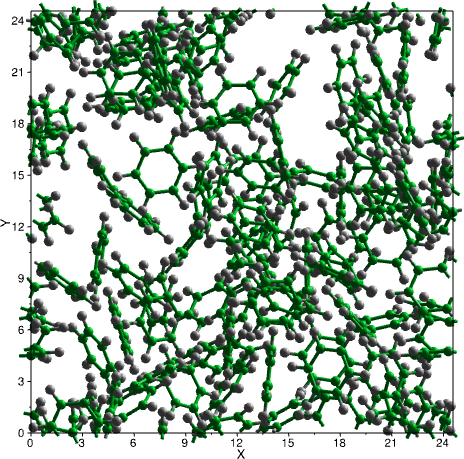Step 2 - Set up a Configuration
Time to create a suitable liquid configuration for our simulation using the predefined “simple random mix” generator:
Configuration ⇨ Create…
Choose the benzene species and press
Leave the configuration type as Mixture and press
Leave the box style as Fixed Geometry, Undefined Size and press
Set the Density to
0.876and the units tog/cm3, and the Multiplier to100. You’ll see that this gives us a box with side length of just over 24.5 Å which is fairly small, but in the interests of speed we’ll go with it for now so hit .
Double-click on the
NewConfiguration tab’s title and change its name to
Liquid

Initial, randomised benzene box containing 100 molecules
Since the molecules were added to the box completely at random, there will most likely be some that overlap quite a lot. Benzene has a ring which makes it possible for molecules to become permanently “interlocked”, but we can do our best to remove such contacts by using what Dissolve (and EPSR) call “size factor scaling”. Basically, this allows the configuration box and the positions of the molecules to be scaled (but keeping the internal geometry intact), removing bad overlaps and letting molecules move safely apart. The factor by which the box is scaled is reduced gradually until the initial requested system size is regained (i.e. corresponding to a size factor of 1.0).
In anticipation of some bad contacts:
Go to the
Liquid configuration tab
Click the on the bottom-left of the window
Drag the
SizeFactor node into the Procedure section to add it
Set the value for the Size Factor to 10.0
Finally, before we move on, we will have to reduce our pair potential range from the default of 15 Å since this is larger than the half the maximum width of our simulation box.
Go to the
Forcefield tab, section
In Control, reduce the pair potential Range from
15to12Å
For a cubic box, you can’t have a cutoff value greater than half the box length, as this means that a given atom will ‘see’ other atoms twice because of the periodic boundary conditions.